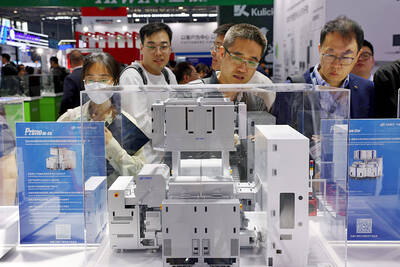Global smartphone maker HTC Corp (宏達電) said yesterday that it is upbeat about its outlook in the second half of this year, expecting sound growth in revenue, profit and shipment figures.
Peter Chou (周永明), chief executive officer of HTC, said at a shareholder meeting that the company will maintain the momentum it built up with its strong growth in the first half of the year.
“If we hadn’t encountered a component shortage, we would have had an even better performance in April and May,” he said.
HTC registered record monthly revenues for two consecutive months in April and last month, which the company attributed to strong market demand for its high-end mobile phones.
Revenue up
In the first five months of the year, the company registered revenue of NT$74.37 billion (US$2.31 billion), up 34 percent from the same period last year.
Despite the large global smartphone market, Chou said HTC was just like a regional team that “accidentally” entered the top four in a world tournament.
Chou, however, said that HTC remains confident about the company’s ability to keep up with its strongest competitors.
According to Canalys, a global research institute that focuses on smartphones, Nokia retained its worldwide smartphone lead during the first quarter this year, with a market share of 38.8 percent.
RIM held onto second place at 19.2 percent, while Apple reached 15.9 percent.
Market share
HTC has a market share of 5.1 percent and Motorola 4.7 percent.
Chou also said that HTC has made significant progress in branding.
According to the company’s internal evaluation index, HTC’s brand awareness was only 10 percent at the end of last year and rose to about 40 percent at present.
It is expected to reach 60 percent by the end of this year, he said.
Meanwhile, at the shareholders meeting, HTC distributed a dividend of NT$26.5 per share for this year — the highest among all listed companies on the Taiwan Stock Exchange.
The company earned net profits of NT$22.6 billion, or NT$28.71 per share, last year.
Its consolidated revenue was NT$144.5 billion last year, with total cellphone shipments of 11.71 million units and an average price of NT$11,661.
The company also said that 3G wireless products accounted for over 95 percent of its total shipments last year, with a gross profit rate of 31.9 percent.

With this year’s Semicon Taiwan trade show set to kick off on Wednesday, market attention has turned to the mass production of advanced packaging technologies and capacity expansion in Taiwan and the US. With traditional scaling reaching physical limits, heterogeneous integration and packaging technologies have emerged as key solutions. Surging demand for artificial intelligence (AI), high-performance computing (HPC) and high-bandwidth memory (HBM) chips has put technologies such as chip-on-wafer-on-substrate (CoWoS), integrated fan-out (InFO), system on integrated chips (SoIC), 3D IC and fan-out panel-level packaging (FOPLP) at the center of semiconductor innovation, making them a major focus at this year’s trade show, according

DEBUT: The trade show is to feature 17 national pavilions, a new high for the event, including from Canada, Costa Rica, Lithuania, Sweden and Vietnam for the first time The Semicon Taiwan trade show, which opens on Wednesday, is expected to see a new high in the number of exhibitors and visitors from around the world, said its organizer, SEMI, which has described the annual event as the “Olympics of the semiconductor industry.” SEMI, which represents companies in the electronics manufacturing and design supply chain, and touts the annual exhibition as the most influential semiconductor trade show in the world, said more than 1,200 enterprises from 56 countries are to showcase their innovations across more than 4,100 booths, and that the event could attract 100,000 visitors. This year’s event features 17

Germany is to establish its first-ever national pavilion at Semicon Taiwan, which starts tomorrow in Taipei, as the country looks to raise its profile and deepen semiconductor ties with Taiwan as global chip demand accelerates. Martin Mayer, a semiconductor investment expert at Germany Trade & Invest (GTAI), Germany’s international economic promotion agency, said before leaving for Taiwan that the nation is a crucial partner in developing Germany’s semiconductor ecosystem. Germany’s debut at the international semiconductor exhibition in Taipei aims to “show presence” and signal its commitment to semiconductors, while building trust with Taiwanese companies, government and industry associations, he said. “The best outcome

Semiconductor equipment billings in Taiwan are expected to double this year, as manufacturers in the industry are keen to expand production to meet strong global demand for artificial intelligence applications, according to SEMI, which represents companies in the electronics manufacturing and design supply chain. Speaking at a news conference before the opening of Semicon Taiwan trade show tomorrow, SEMI director of industry research and statistics Clark Tseng (曾瑞榆) said semiconductor equipment billings in Taiwan are expected to grow by an annual 100 percent this year, beating an earlier estimate of 70 percent growth. He said that Taiwan received a boost from a